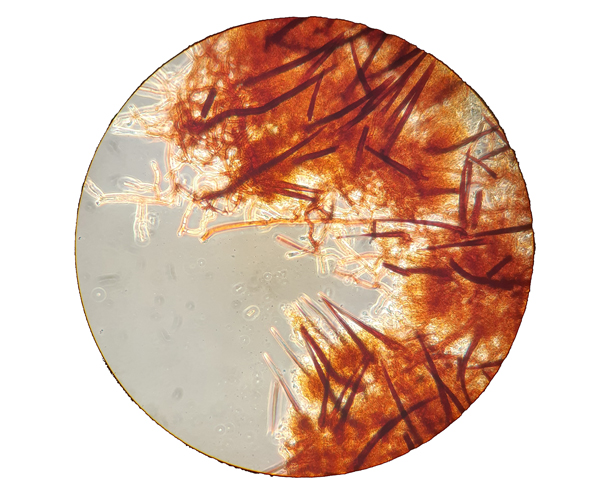Petra Fransson

Presentation
I have a background in plant and fungal ecology and defended my PhD thesis at SLU in 2002. After a post doc in Aberdeen, Scotland, I continued my work at the department as Associate Professor in the Forest Microbiology group. Since my PhD I am interested in ectomycorrhizal fungi, a group of fungi that colonize the roots of woody perennial plants and enhance the uptake of resources such as nitrogen and water in exchange for carbon fixed by their host plant. This work is continued in a PhD project on mycorrhizal mineral weathering within the research group, and I have several ongoing collaborations with other research groups at the department, nationally (SLU, Stockholm University) and internationally (Rostock University, Copenhagen University, Hutton Institute). Since 2022 I also work part time as vice-dean with responsibility for research education at the NJ-faculty.
Teaching
- Mycological knowledge - Introduction to mycology (first cycle) 7.5 hp. Covers the basis in fungal biology and ecology, and how to recognise common fungi. Runs yearly since 2017.
- Mycological knowledge - Advanced basic course in mycology (first cycle) 7.5 hp. Fungal diversity, biology and their function in nature and for humans, microscopy and species determination. Runs yearly since 2018.
- These two distance-based courses in basic fungal knowledge we teach in Swedish (‘Svampkunskap – en introduktion till mykologi’ and ‘Svampkunskap – fortsättningskurs i mykologi’).
- Root-soil-microbe interactions (PhD course) 4.5 HEC - course responsible and teaching, 2011, 2019, 2020 and 2024. Covers beneficial interactions in the rhizosphere context in both agricultural and forest ecosystems.

Research
Ectomycorrhizal fungi and mineral weathering in boreal forests
The role of ectomycorrhizal (ECM) fungi in biological weathering is increasingly recognised, and ECM fungi can weather minerals and mobilise essential nutrients such as base cations by physical force, extrusion of low molecular weight organic acids, protons, free radicals and siderophores. Suillus species in particular are found to preferentially inhabit mineral soils and are frequently reported to possess weathering capabilities. In Kat King’s PhD project we work together with Marisol Sanchez-Garcia and Roger Finlay to investigate cation transporter family evolution, expression in experimental and environmental samples, and cation mobilization in Suillus spp. in relation to mineral weathering.

The moss microbiome as mediator of forest nitrogen and carbon cycling
The future carbon sequestration potential of the boreal zone is tightly linked to nitrogen availability as production is chronically nitrogen limited. The main source of new nitrogen is through N2-fixation, mainly from microbial communities in the bryosphere, playing a key, but poorly understood, role in integrating above- and belowground processes. In this FORMAS funded project (FORMAS 2020-01100) I work with Sara Hallin, Karina Clemmensen, Jaanis Juhanson and Signe Lett (Copenhagen University) on the role of the moss microbiome in forest nitrogen cycling to understand microbial mediated biochemical process.

Do mycorrhiza protect spruce from spruce bark beetle in periods of drought?
Spruce trees are sensitive to drought and the climate change predictions are that drought events will become more common under future climate conditions. This project sets out to create a better understanding of the relationship between soil moisture conditions, spruce mycorrhiza and spruce bark beetle susceptibility. The work will be based around a PhD project (currently recruiting) in collaboration with Maartje Klapwijk, Ecology Department, and includes a field based drought experiment and insect attack boxes.
Linking plant traits to productivity and ecosystem processes
For the last ten years I have collaborated with the group of Martin Weih (Department of Plant Production Ecology, SLU) and Christel Baum (Rostock, Germany) on a Salix model system to link plant functional traits, diversity and ecosystem processes. In the PhD project of Joel Jensen we now focus on carbon sequestration in mixed tree plantations.
Effects of soil management and droughts on soil microbial communities and productivity in Swedish grasslands
In this project we study how drought resilience and carbon cycling interacts with grassland biodiversity at Tovetorp Field Station. We investigate how fungal and bacterial community diversity, vascular plant diversity, root dynamics and soil carbon turnover respond to drought (rain exclosures) and soil amendment treatments with organic compost is studied over time. This is done in a collaboration with PhD student Daniela Guasconi, Gustaf Hugelius and Stefano Manzoni at Stockholm University.

Selected publications
Guasconi D, Clemmensen K, Cousins SAO, Hugelius G, Juhanson J, Roth N, Fransson P. 2023. Vegetation, topography and soil depth drive microbial community structure in two Swedish grasslands. FEMS Microbiology Ecology (revisions).
Yang H, Fang C, Li Y, Wu Y, Fransson P, Rillig MC, Zhai S, Xie J, Tong Z, Zhang Q, Sheteiwy MS, Li F, Weih M. 2022. Temporal complementarity between roots and mycorrhizal fungi drives wheat nitrogen use efficiency. New Phytologist doi: 10.1111/nph.18419.
Mielke L, Ekblad A, Finlay R, Fransson P, Lindahl BD, Clemmensen K. 2022. Ericaceous dwarf shrubs contribute a significant but drought-sensitive fraction of soil respiration in a boreal pine forest. Journal of Ecology.
Hoeber S, Baum C, Weih M, Manzoni S, Fransson P. 2021. Site-dependent relationships between fungal community composition, plant genotypic diversity and environmental drivers in a Salix biomass system. Frontiers Fungal Biology 2:671270. Doi: 10.3389/ffunb.2021.671270.
Cheeke T, Philipps RP, Kuhn A, Rosling A, Fransson P. 2020. Variation in hyphal production rather than turnover regulates standing fungal biomass in temperate hardwood forests. Ecology 102: e03260. Doi: 10.1002/ecy.3260.
Hoeber S, Fransson P, Weih M, Manzoni S. 2020. Leaf litter quality coupled to Salix variety drives litter decomposition more than stand diversity or climate. Plant and Soil 453: 313-328. Doi:10.1007/s11104-020-04606-0
Hagenbo A, Hadden D, Clemmensen KE, Grelle A, Manzoni S, Mölder M, Ekblad A, Fransson P. 2019. Carbon use efficiency of mycorrhizal fungal mycelia increases during the growing season but decreases with forest age across a Pinus sylvestris chronosequence. Journal of Ecology 107: 2808-2822. Doi: 10.1111/1365-2745.13209.
Baum C, Hrynkiewics K, Szymánska S, Vitow N, Hoeber S, Fransson P, Weih M. 2018. Mixture of Salix genotypes promotes root colonization with dark septate endophytes and changes P cycling in the mycorrhizosphere. Frontiers in Microbiology 9: 1012. Doi: 10.3389/fmicb.2018.01012.
Hagenbo A, Kyaschenko J, Clemmensen KE, Lindahl BD, Fransson P. 2018. Fungal community shifts underpin declining mycelial production and turnover across a Pinus sylvestris chronosequence. Journal of Ecology 106: 490-501. Doi: 10.1111/1365-2745.12917.
Hagenbo A, Clemmensen KE, Finlay RD, Kyaschenko J, Lindahl BD, Fransson P*, Ekblad A*. 2017. Changes in turnover rather than production regulate biomass of ectomycorrhizal fungal mycelium across a Pinus sylvestris chronosequence. New Phytologist 214: 424-431. * shared last authorship. Doi: 10.1111/nph.14379.
Cheeke TE, Phillips RP, Brzostek ER, Rosling A, Bever JD, Fransson P. 2016. Dominant mycorrhizal association of trees alters carbon and nutrient cycling by selecting for microbial groups with distinct enzyme function. New Phytologist 214: 432-442. Doi: 10.1111/nph.14343.
Fransson P, Andersson A, Norström S, Bylund D, Bent E. 2016. Ectomycorrhizal exudates and pre-exposure to elevated CO2 affects soil bacterial growth and community structure. Fungal Ecology 20: 211-224. Doi: 10.1016/j.funeco.2016.01.003.
Rosling A, Midgley MG, Cheeke T, Urbina H, Fransson P, Phillips R. 2016. Phosphorous cycling in deciduous forest soil differs between stands dominated by ecto- and arbuscular mycorrhizal trees. New Phytologist 209: 1184-1195. Doi: 10.1111/nph.13720.
Weih M, Hoeber S, Beyer F, Fransson P. 2014. Traits to ecosystems: the ecological sustainability challenge when developing future energy crops. Frontiers in Energy Research 2: 1-5. Doi: 10.3389/fenrg.2014.00017.
Fransson P. 2012. Elevated CO2 impacts ectomycorrhiza-mediated forest soil carbon flow: fungal biomass production, respiration and exudation. Fungal Ecology 5: 85-98. Doi: 10.1016/j.funeco.2011.10.001.
Fransson PMA, Johansson EM. 2010. Elevated CO2 and nitrogen influence exudation of soluble organic compounds by ectomycorrhizal root systems. FEMS Microbiology Ecology 71: 186-196. Doi: 10.1111/j.1574-6941.2009.00795.x.
Fransson PMA. 2004a. Craterellus tubaeformis (Fr.) Quél. (syn. Cantharellus tubaeformis Fr.: Fr.) + Quercus robur L. Descriptions of Ectomycorrhizae 7/8: 37-43.
Högberg P, Plamboeck, AH, Taylor AFS & Fransson PMA. 1999. Natural 13C abundance reveals trophic status of fungi and host-origin of carbon in mycorrhizal fungi in mixed forests. Proceedings of the National Academy of Sciences. 96: 8534-8539. doi: 10.1073/pnas.96.15.8534.